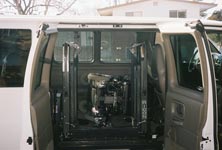Wheelchair Safety
 |
 |
| What happens when a tie down becomes loose? 20 February 2008 | |
|---|---|
 |
||||||||||
| Home | Resource Links | Forms | Newsletter | Utah Bulletin Board | FAQ | Contact Us | About Us | Site Map |  |
|
Wheelchair transportation is serious business. Primary concern is safety of the wheelchair user followed closely by safety and protection of all wheelchair equipment. It doesn't take a high speed impact to cause significant injury to an individual or damage to expensive, high tech (not to mention high dollar) equipment.
The incident pictured above occurred when the van driver took evasive action to avoid colliding with a driver making an improper left turn from the through traffic lane instead of the turn lane. No impact between vehicles occurred. The maneuver occurred at lower speed (under 25 mph) but was still fast enough that an improperly secured tie-down released allowing the PerMobile C400 to tip seat first into the rear of the driver's seat. This did cause functional damage to the wheelchair's seating and hydraulic systems. The wheelchair owner of the above pictured wheelchair does NOT travel while seated in the wheelchair, choosing instead to transfer securely to a manufacturer installed captain's seat with approved full lap belt and shoulder restraints. Possible head, neck, shoulder and left arm injuries could have occurred had the wheelchair owner been seated in the chair at the time of the accident. Fortunately she was securely seated and restrained away from the wheelchair and was uninjured. The wheelchair required 2 full days of shop time to repair the damage. Linda recommends reviewing wheelchair transportation safety information provided by Rehabilitation Engineering Research Center (RERC) on Wheelchair Transportation Safety found here: http://wc-transportation-safety.umtri.umich.edu and reading Ride Safe: Vehicle Safety For People Who Use Wheelchairs http://www.travelsafer.org
|
||||||||
© June 2004-January 2026 Special Needs Resource Project |